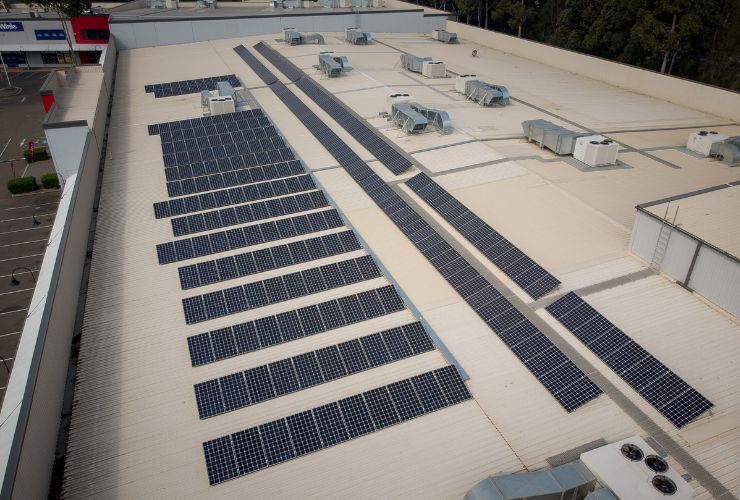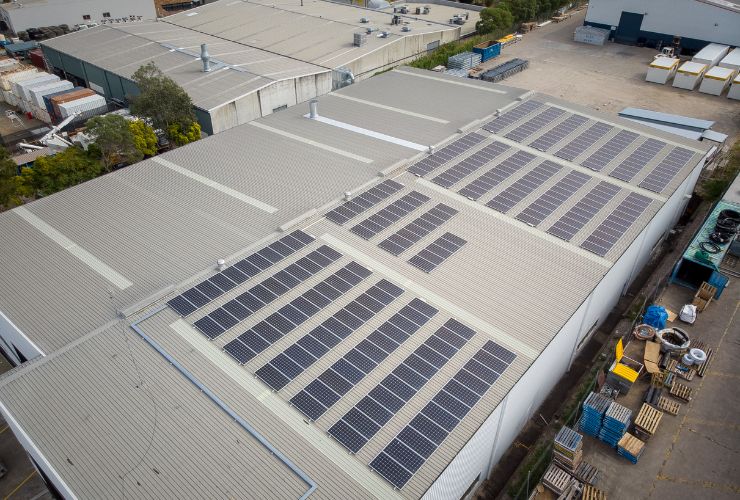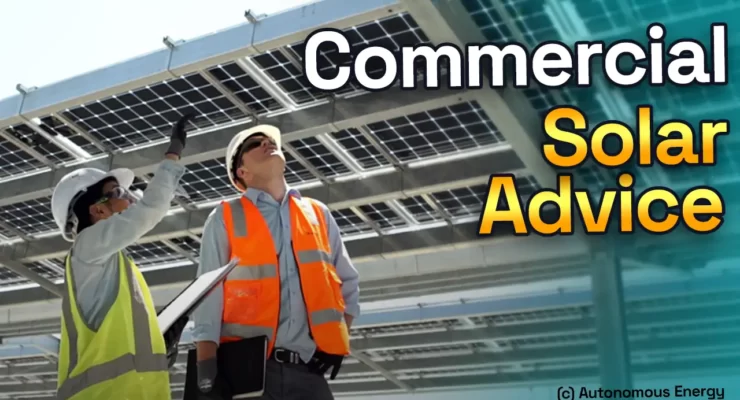Fast read
Building a commercial solar system involves several essential stages. For large projects such as malls or storage buildings, it is crucial to seek assistance from a solar expert.
The expert will help in planning, sizing, and designing the solar system. This ensures that the project is successful and efficient. Smaller projects can be handled by the solar company itself to ensure optimal system performance.
The process includes concept design, determining system size, and financial modelling based on energy consumption patterns. A commercial solar project bidding document is created, specifying requirements and inviting competitive submissions.
Best commercial solar system – How to get the right advice
In the case of large commercial solar systems like shopping centres, you have to work with a professional. We recommend an experienced independent solar consultant (ISC) or solar engineer.
Conversely, for smaller projects, the solar company can handle everything. Buying the right commercial solar system is tricky. Often, many purchasers rely on the commercial solar installation company for information.
However, this advice should be double-checked, as sometimes the company will not give all the details. Since they are not communication professionals, learning about the process and potential pitfalls is a wise course of action.
Furthermore, understanding the stages of a commercial solar project is essential.
What are some of the stages of getting the best commercial solar system?
1. Concept design and system size
- During this stage, energy needs and drivers are assessed. Site conditions are matched with infrastructure. System location and space are considered.
- The existing electrical infrastructure must be assessed. Grid connection must be checked for suitability. For roof mounts, a structural check is needed. This ascertains the roof’s suitability.
- Ground mount systems need a geotechnical assessment. A detailed list of requirements is in the next section.
To determine the right system size, each business’s unique needs must be considered. Energy consumption patterns may vary. They can change daily, weekly, or seasonally.
Each system must be tailor-designed after an energy assessment. This includes analysing existing energy usage. It predicts future electricity needs.
The final evaluation will provide energy modelling. This maximises the benefits of the commercial solar system, including battery storage.
2. Work out the system requirements and undertake some financial modelling
Most customers seek to purchase a tailor-made commercial solar system to match energy demands. This is done by looking at how much energy is used and comparing it to how much solar power is produced.

3. Create a commercial solar project tender document
As each business has unique needs, each commercial solar PV system must be tailor-designed, considering the specific site and the local energy assessment. The client sends out a document for price quotes or bids for large-scale projects. They do this after figuring out all the project details and needs.
Afterwards, an Independent Solar Consultant (ISC) helps to get a good price and result for the commercial solar project. Following that, the bidding document will then be distributed to appropriate solar industry companies. Then, the completed submissions will be reviewed in conjunction with the ISC.
This evaluation examines what the solar company provides, how they complete projects, the price, and the system’s effectiveness. The evaluation considers the offerings of the commercial solar company. It also looks at how projects are delivered by the company.
Lastly, the evaluation assesses how well the system functions. The assessment should take into account previous experience with similar projects. It should also include detailed lists of what is covered, long-term support, output warranties, and other factors.
4. Building the best commercial solar system
Once the tendering process is completed, it is time to start building the best commercial solar system. The winning company needs to request permission to connect their system to the grid. They must also ensure that they comply with all rules and technical requirements. This must be done before they can proceed with installing the system on-site.
At the end of the construction stage, the Distribution Network Service Provider (DNSP) may inspect the site and energise the system, provided the commercial solar system installation was done according to requirements. At this point, the system will be in full operation.
Suppose an ISC was appointed to manage the project. In that situation, their main tasks would be to make sure the site is safe, check quality, and train staff.
They need to make sure the site is safe and that quality control is being maintained. Additionally, they must ensure that all staff members are trained adequately for their roles. Additionally, they must see to it that system documentation occurs before completion and handover.

So, here are the key steps in clear order:
- First, clarify your purchase drivers: Identify the primary reasons for investing in a commercial solar system. This might include reducing energy costs, utilising renewable energy, or meeting sustainability goals. Having clear drivers will guide the rest of the process and align the project with organisational objectives.
- Next, undertake the financial modelling: Analyse the cost structure, potential savings, and return on investment (ROI) for the commercial solar project. This step includes estimating installation costs, maintenance, potential government incentives, and savings on electricity bills over time.
- Then, size the system: Determine the optimal size of the commercial solar system based on the energy consumption pattern of the building, available roof space, and budget constraints. Proper sizing ensures that the system meets energy needs without excessive oversizing, which might lead to unnecessary costs.
- Following that, determine the detailed design: Finalise the specific layout, components, and engineering aspects of the commercial solar system. This includes selecting the type of panels, inverters, and mounting systems, and ensuring compliance with local building codes.
- Subsequently, gain quotes: Request quotes from multiple commercial solar providers, detailing the costs of equipment, installation, and any ongoing maintenance. This phase allows for comparing pricing and services offered by different vendors.
- Afterwards, obtain approvals, including checks regarding any potential connection to grid hurdles: Secure necessary permissions and understand potential barriers to connecting the system to the local electrical grid. This may involve coordination with utility providers, and regulatory authorities, and ensuring that the connection meets all applicable standards.
Running the Tender
- Run the tender process: Manage the process of inviting, receiving, and reviewing bids. This involves creating deadlines, holding meetings before bids, and making sure the process is open and fair for all vendors.
- Next, compare quotes: Evaluate the bids based on price, high quality, vendor experience, and alignment with project goals. This side-by-side comparison helps in shortlisting the most promising offers.
- Then, undertake a compliance check: Confirm that the selected vendors comply with all relevant laws, regulations, and industry standards. This might include checking licences, insurance, safety records, and other qualifications.
- If needed, get expert help to determine the best tender – in case you do not have this in-house: Consult with an independent solar energy consultant or technical expert to evaluate bids if internal expertise is lacking. This ensures that the evaluation is thorough and considers all relevant technical and financial aspects.
- Subsequently, gain required permits: Obtain all necessary permits, including building permits, electrical permits, and any special permissions required for the installation and operation of the commercial solar system. This step ensures legal compliance with local authorities.



